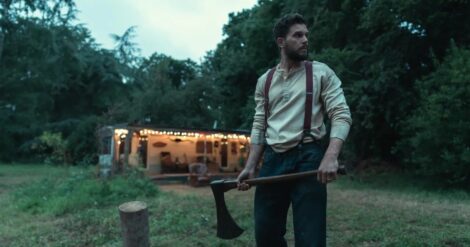‘There are two wolves in all of us…”
THE BEAST WITHIN, directed by Alexander J. Farrell and screened at the Fantasia International Film Festival, attempts to bring the horror of lycanthropy to life as a metaphor for domestic violence. The movie follows an entire isolated family, but the story is told through the eyes of the young daughter Willow (Caoilinn Springall), and through her perspective the film explores the emotional turmoil of living with a werewolf family member. However, much like a full moon obscured by clouds, the movie’s true impact is hidden behind a lackluster execution and underwhelming drama. Farrell, known more for his documentaries, struggles to blend horror and serious themes effectively, which leaves THE BEAST WITHIN looking for a better direction. Ultimately, this werewolf tale lacks bite, making it a disappointing addition to the genre.
Living in a very unconventional household, a young girl with some pretty serious breathing issues resides in a rural location. Her family consists of her distant father Noah (Kit Harington), her anxious mother Imogen (Ashleigh Cummings), and her stoic grandfather Waylon (James Cosmo). The house is old and worn, and the cold dead eyes of taxidermized animals watch over this isolated home. At just ten years old Willow only knows her current way of life, but now she is beginning to question some things: Why do they live so far away? What happens in the woods after dark? And why does her father disappear every few weeks?
Willow does not know where her father goes, but she sees the state he is in when he returns—barely able to walk and needing to be bedridden for a while—but no one will tell her what is wrong. The film employs this secrecy to craft a pointed allegory for living in an abusive household. Rather than depicting alcoholism or another common affliction, the story uses lycanthropy (werewolf transformation) as a metaphor for domestic abuse. This condition profoundly impacts Noah’s behavior as it disrupts his daily life, strains his relationships, and undermines his role as a father. His unpredictable moods and physical deterioration reflect the destructive effects of his condition, which mirrors the emotional and psychological turmoil experienced by victims of abuse.
Willow adores her father, not just because he’s her dad, but because her world is so limited. Living in isolation with barely any outside influence, he’s her main source of love and affection. When he turns distant or aggressive, it feels like a huge part of her small world is falling apart. Even though he has moments where he’s genuinely tender and connects with her, these moments can quickly shift into something dark and frightening. His erratic behavior creates a rollercoaster of emotions for Willow, which makes her feel like the ground beneath her is constantly shifting. This instability in her father’s affection leaves her feeling vulnerable and unsettled and highlights just how fragile her small, isolated world really is.

The film features a standout cast, with a particularly impressive performance from Springall, who delivers a powerful and nuanced portrayal of a sick girl caught in a perilous situation. Her ability to convey vulnerability and fear brings an emotional depth to the role that really anchors the story. However, despite the strong acting from Kit Harington and James Cosmo, the movie does not fully capitalize on their talents. Harington’s role (while significant) does not offer the range and complexity one might expect from his previous performances (Game of Thrones), leaving some of his potential unutilized. Similarly, Cosmo’s character, though crucial to the narrative, lacks the depth and development that would allow him to showcase his full range (Highlander, Braveheart). This missed opportunity somewhat undercuts the impact of the film’s otherwise strong cast.
Since the silent era of film monsters have often served as metaphors for deeper, more complex issues, as they embody fears and societal concerns that extend beyond their grotesque appearances. BEAST WITHIN, while not breaking new ground in its exploration of monsters as symbols, does offer something new in using lycanthropy to reflect domestic abuse, but misses the mark in its delivery. Rather than subtly weaving the metaphor into the narrative, the film hits the audience over the head with its intended message and thus leaves little room for interpretation. A more nuanced approach could have enriched the connection between the monster and domestic abuse, which would have allowed the metaphor to unfold naturally while giving audiences a richer, more engaging monster experience. This would have balanced the thematic depth with the enjoyment of a more effectively realized horror element.
Overall, the werewolf serves as a potent metaphor for domestic violence, which adds a layer of social commentary to the horror. Despite boasting a strong cast and an intriguing concept, THE BEAST WITHIN falls short of fully realizing its potential. So, while the film has moments of brilliance, it ultimately struggles to deliver a consistently engaging experience. The narrative often feels underdeveloped, and the heavy-handed metaphor sometimes overshadows the horror elements, leaving viewers wanting more of the werewolf action that the premise promised.

Tags: Alexander J Farrell, Ashleigh Cummings, Braveheart, Caoilinn Springall, Fantasia Film Festival, Fantasia Film Festival 2024, Film Festivals, Game of Thrones, Highlander, James Cosmo, Kit Harington, The Beast Within


No Comments